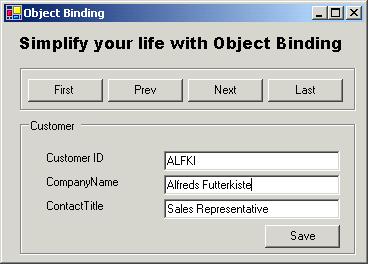Simplify your life with Object Binding
Author: Iqbal Khan
The .NET framework provides a very flexible and powerful approach to databinding that cuts down a lot of redundant code and simplifies the development process significantly. Unlike the earlier databinding models, which were limited to single data source, the .NET framework provides read/write (two ways) link to a large number of data sources such as DataSets, DataTables, Collections and also textboxes, checkboxes, radio buttons and so on.
In the following object binding example you'll see how easy it is to implement a record navigation with TierDeveloper generated objects with single line of hand-written code. Let's say you've three textbox controls on a win form and you loaded all customers in a collection by calling getAll method of customers factory class.

Here is how you might want to load customers and then bind the attributes to text controls (in your case you might have datagrid or other UI components)
Public csColl As CustomersCollection
Private Sub btnLoad_Click(ByVal sender As System.Object, ByVal e As System.EventArgs)
Handles btnLoad.Click
Dim objCustomer As Customers = New Customers
Dim objFactory As CustomersFactory = New CustomersFactory
csColl = New CustomersCollection
csColl = objFactory.getAll()
txtCustomerId.DataBindings.Add("Text", csColl, "CustomerID")
txtCompanyName.DataBindings.Add("Text", csColl, "CompanyName")
txtContactTitle.DataBindings.Add("Text", csColl, "ContactTitle")
End SubThe CurrencyManager is used to keep data-bound controls synchronized with each other. The Position property of CurrencyManager is used to determine the current position of all controls. Your click event handler for Next button might look like this:
Private Sub btnNext_Click (ByVal sender As System.Object, ByVal e As System.EventArgs)
Handles btnNext.Click
Dim cm As CurrencyManager = CType (Me.BindingContext (csColl), CurrencyManager)
If cm.Position < cm.Count - 1 Then
cm.Position += 1
End If
End Sub
Private Sub btnPrev_Click (ByVal sender As System.Object, ByVal e As System.EventArgs)
Handles btnPrev.Click
Dim cm As CurrencyManager = CType (Me.BindingContext (csColl), CurrencyManager)
If cm.Position > 0 Then
cm.Position -= 1
End If
End SubYou might allow users to make changes to any records and then persist those changes when the user clicks SAVE button. Your click event handler for Save button might persist the changes with a single call as illustrated below.
Private Sub btnSave_Click(ByVal sender As System.Object, ByVal e As System.EventArgs)
Handles btnSave.Click Dim cf As CustomersFactory = New CustomersFactory
cf.Save(csColl, 0)
End SubAuthor: Iqbal Khan works for Alachisoft , a leading software company providing .NET and Java distributed caching, O/R Mapping and SharePoint Storage Optimization solutions. You can reach him at iqbal@alachisoft.com.